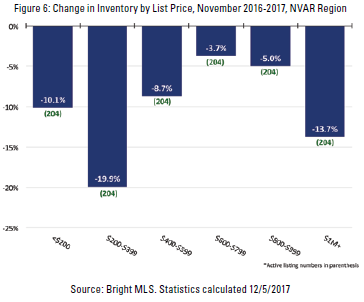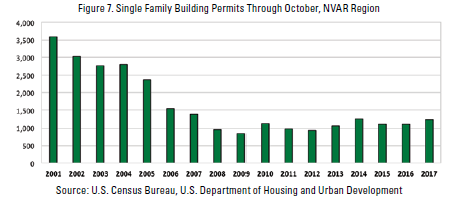THROUGHOUT 2017, the economy of the Northern Virginia Association of Realtors® region grew at a slower, yet steady pace. However, in that footprint, which covers Alexandria City, Arlington County, Fairfax County, Fairfax City and Falls Church City, home sales growth stalled in the latter part of the year due to low inventory and climbing home prices. Given these conditions, can the housing market continue to grow, even as the number of new jobs being added to the region is slowing? It is likely that inventory levels in the NVAR region – particularly for homes in the lower price range – will determine the housing market’s 2018 outlook.
SLOWING JOB GROWTH, LOW UNEMPLOYMENT
The Northern Virginia region, which includes counties of Arlington, Clarke, Fairfax, Fauquier, Loudoun, Prince William, Spotsylvania, Stafford and Warren, and cities of Alexandria, Fairfax, Falls Church, Fredericksburg, Manassas and Manassas Park, has seen a reduction in job growth relative to 2016 (Figure 1). This slowing of job growth can be partially attributed to the continued decrease in unemployment between 2016 and 2017. The NVAR region’s unemployment rate declined from 3.2 percent in October 2016 to 2.8 percent in October 2017, as the labor market approached full employment. Between October 2016 and October 2017, the region added 13,300 jobs, including 8,000 Professional and Business Services jobs (Figure 2). Although this may not be the largest absolute increase in Professional and Business Services jobs, it makes up the largest proportion of overall job growth since 2014: 80 percent of new jobs in the region between October 2016 and October 2017 were in that sector.

Despite the slowing growth of payroll jobs throughout the Northern Virginia region, the number of residents in the NVAR region’s labor force has grown substantially over the past year (Figure 3). The labor force includes residents who are either employed or actively looking for a job. Between 2012 and 2016 this number had been relatively f lat. In the first 10 months of 2017, the labor force increased 1.6 percent compared to 1.2 percent over the same period in 2016.

HOUSING GROWTH RESTRAINED BY LOW INVENTORY
The region’s buying conditions, in theory, are relatively good. Jobs are growing steadily, and low mortgage interest rates are helping keep financing costs low. Erratic sales growth throughout 2017 has resulted from the NVAR region’s consistently low inventory and high home prices (Figure 4). Nevertheless, year-to-date sales as of November 2017 are up 4.9 percent over the same period last year at 21,047 closed sales.

Inventory decline moderated somewhat as 2017 progressed. At the end of November, the NVAR region had 3,236 active listings; down 11.4 percent from that point last year, compared to the 2017 low in April, a 19.9 percent year-over-year decrease. The latter part of 2017 brought marginally increased listings and decreased sales, contributing to the slight loosening of inventory. Year-to- date new listings were up 1 percent as of November 2017, compared to the same time period in 2016.
However, the lack of homes available to buy at a reasonable price for most buyers is the missing piece of the equation. With more available homes on the market, the region could have fared better. The lack of lower priced homes likely contributed to people remaining renters or leaving the area, resulting in missed potential home sales.
Overall, 2017 saw increased prices with a median home sale price of $502,000 through November – an increase of 3.2 percent from the same period in 2016. Moving into 2018, prices in the region remain nearly 6.4 percent higher than they were one year ago, with a standing monthly median sale price of $499,900 in October 2017 (Figure 5). The 12-month average median sale price was $499,170 in November.

The critical lack of supply at the low end of the market drives these high prices, as this is where the most demand exists. Increased competition means that lower- priced homes experience bigger price gains than higher-priced homes.

The number of the region’s active listings decreased significantly more in the lower listing price categories (Figure 6). Inventory decreased 19.9 percent year- over-year in November 2017 for homes listed between $200,000 and $400,000, and increased 4.2 percent over the same period for homes listed between $600,000 and $1,000,000. Although beginning to decrease like the rest of the housing stock, homes listed at price points greater than $1 million make up the largest share of inventory at 816 active listings. Increased residential housing starts, especially at the starter home level, are the key to bringing home prices down.
NEW CONSTRUCTION POISED TO PICK UP
Inventory problems are partially the result of construction not keeping up with demand. Nationally, home building levels have not recovered from the Great Recession – total housing starts (new residential construction) are at 50 percent of their 2006 levels, the housing boom’s peak. Low supply of homes for sale provides an opportunity for the nation’s homebuilders, as they are currently not building enough inexpensive houses to meet market needs.
Recent signs show that a pickup in national home construction rates is on the horizon. Total housing starts increased 13.7 percent nationally in October according to a joint data release from the U.S. Census Bureau and U.S. Department of Housing and Urban Development, reaching a one-year record high, with solid readings from the single-family sector. Builder confidence in the market for newly-built single-family homes rose two points to a level of 70 in November on the National Association of Home Builders/Wells Fargo Housing Market Index (HMI). New family home size is also decreasing nationally, after increasing to all-time highs in 2013 and leveling off in 2014 and 2015. According to third quarter 2017 data from the U.S. Census Quarterly Starts and Completions by Purpose and Design, median square footage of new single-family homes decreased 3 percent from 2016 to 2,378 square feet.
Building permit data at the local level is a reasonable indicator of future construction conditions. These data, which also are jointly released by the U.S. Census Bureau and HUD, show that single-family building permits in the NVAR region were up more than 12 percent year-to-date as of October 2017 compared to 2016 (Figure 7).

LOOKING AHEAD!
2018 HOUSING MARKET WILL DEPEND ON INVENTORY LEVELS AND THE IMPACT OF REGULATION.
Looking forward to 2018, the impact of the federal budget continues to be the region’s biggest source of economic uncertainty. The Washington region’s economy remains tied to the federal government, either through direct employment or federal contracting and procurement. Therefore, potential decreases in the size of the federal government or its spending could have adverse effects on the economic viability of the region and negatively impact its housing market.
In addition, modifications of the current tax system could impact the housing market moving forward. For example, capping the mortgage interest deduction at $750,000 down from $1,000,000 would uniquely impact the NVAR region. As of October, 1,589 homes in the NVAR region in 2017 sold for more than $1,000,000. During the same period, 7,986 homes were purchased for between $500,000 and $1,000,000. Under a new mortgage interest deduction cap, nearly 8,000, or 42 percent of new sales from 2017 alone, would be affected by a change in tax code, along with an increased tax burden placed on new sales above $1,000,000. The lower cap would be particularly detrimental to first-time buyers in the NVAR region’s expensive market. Existing mortgages would be exempt, creating a distinction between current and future homeownership. This would create a disincentive to move, intensifying an already severe inventory shortage at the entry level.
Irrespective of regulatory changes, demand for single-family housing is increasing at a consistent pace, driven by job and economic growth, demographic change, and limited housing inventory. With these economic fundamentals in place, upward movement of the single-family housing market should continue this year.
Expect low inventory to continue to push up home prices, but at a slower pace. This moderation of inventory shrinkage depends primarily on new home construction. With a large generation of new homeowners entering the market and an inventory crisis that leaves them with few options, it is expected that builders will not ignore this market. Ideally, 2018 will bring a rise in new construction at the more affordable end of the market, yet how fast this will occur remains to be seen.